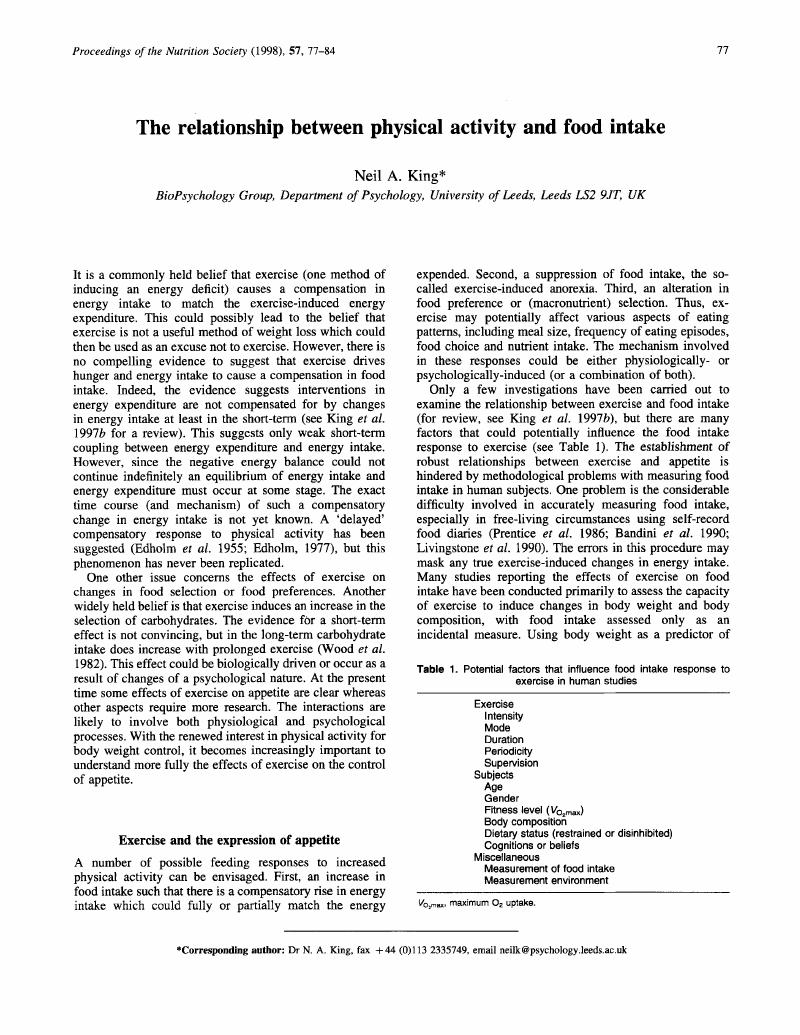Crossref Citations
This article has been cited by the following publications. This list is generated based on data provided by Crossref.
Gardner, David S.
Jackson, Alan A.
and
Langley-Evans, Simon C.
1998.
The effect of prenatal diet and glucocorticoids on growth and systolic blood pressure in the rat.
Proceedings of the Nutrition Society,
Vol. 57,
Issue. 02,
p.
235.
James Stubbs, R
and
O’Reilly, Leona
1999.
Neural and Metabolic Control of Macronutrient Intake.
BLUNDELL, JOHN E.
and
KING, NEIL A.
1999.
Physical activity and regulation of food intake: current evidence.
Medicine & Science in Sports & Exercise,
Vol. 31,
Issue. Supplement 1,
p.
S573.
Bellisle, France
1999.
Food choice, appetite and physical activity.
Public Health Nutrition,
Vol. 2,
Issue. 3a,
p.
357.
Carey, Gale B.
2000.
Cellular adaptations in fat tissue of exercise-trained miniature swine: role of excess energy intake.
Journal of Applied Physiology,
Vol. 88,
Issue. 3,
p.
881.
Blundell, J. E.
Stubbs, R. J.
Hughes, D. A.
Whybrow, S.
and
King, N. A.
2003.
Cross talk between physical activity and appetite control: does physical activity stimulate appetite?.
Proceedings of the Nutrition Society,
Vol. 62,
Issue. 3,
p.
651.
Perry, Arlette C.
Rosenblatt, Evelyn B.
and
Wang, Xuewen
2004.
Physical, Behavioral, and Body Image Characteristics in a Tri‐Racial Group of Adolescent Girls.
Obesity Research,
Vol. 12,
Issue. 10,
p.
1670.
Blundell, J
King, N
and
Bryant, E
2005.
Childhood Obesity.
Vol. 20050737,
Issue. ,
p.
135.
Denburg, Judah A
Hatfield, Holly M
Cyr, Michael M
Hayes, Lisa
Holt, Patrick G
Sehmi, Roma
Dunstan, Janet A
and
Prescott, Susan L
2005.
Fish Oil Supplementation in Pregnancy Modifies Neonatal Progenitors at Birth in Infants at Risk of Atopy.
Pediatric Research,
Vol. 57,
Issue. 2,
p.
276.
Uauy, Ricardo
and
Díaz, Erik
2005.
Consequences of food energy excess and positive energy balance.
Public Health Nutrition,
Vol. 8,
Issue. 7a,
p.
1077.
Stubbs, R. J.
and
Tolkamp, B. J.
2006.
Control of energy balance in relation to energy intake and energy expenditure in animals and man: an ecological perspective.
British Journal of Nutrition,
Vol. 95,
Issue. 4,
p.
657.
King, N A
Hester, J
and
Gately, P J
2007.
The effect of a medium-term activity- and diet-induced energy deficit on subjective appetite sensations in obese children.
International Journal of Obesity,
Vol. 31,
Issue. 2,
p.
334.
Cannon, Geoffrey
2008.
Out of the Box.
Public Health Nutrition,
Vol. 11,
Issue. 6,
p.
550.
McNeil, Jessica
Riou, Marie-Ève
Razmjou, Sahar
Cadieux, Sébastien
and
Doucet, Éric
2012.
Reproducibility of a food menu to measure energy and macronutrient intakes in a laboratory and under real-life conditions.
British Journal of Nutrition,
Vol. 108,
Issue. 7,
p.
1316.
Naughton, Paul
McCarthy, Sinéad N.
and
McCarthy, Mary B.
2015.
The creation of a healthy eating motivation score and its association with food choice and physical activity in a cross sectional sample of Irish adults.
International Journal of Behavioral Nutrition and Physical Activity,
Vol. 12,
Issue. 1,
Hunschede, Sascha
El Khoury, Dalia
Antoine-Jonville, Sophie
Smith, Christopher
Thomas, Scott
and
Anderson, G. Harvey
2015.
Acute changes in substrate oxidation do not affect short-term food intake in healthy boys and men.
Applied Physiology, Nutrition, and Metabolism,
Vol. 40,
Issue. 2,
p.
168.
Ferrão, Ana Cristina
Guiné, Raquel P.F.
Correia, Paula
Ferreira, Manuela
Cardoso, Ana Paula
Duarte, João
and
Lima, João
2018.
Perceptions towards a healthy diet among a sample of university people in Portugal.
Nutrition & Food Science,
Vol. 48,
Issue. 4,
p.
669.
Myers, Courtney
McCartney, Danielle
Desbrow, Ben
Khalesi, Saman
and
Irwin, Christopher
2021.
Consumption of a smoothie or cereal-based breakfast: impact on thirst, hunger, appetite and subsequent dietary intake.
International Journal of Food Sciences and Nutrition,
Vol. 72,
Issue. 1,
p.
123.
Lyu, Weida
Tanaka, Tomoki
Son, Bo-Kyung
Akishita, Masahiro
and
Iijima, Katsuya
2022.
Associations of multi-faceted factors and their combinations with frailty in Japanese community-dwelling older adults: Kashiwa cohort study.
Archives of Gerontology and Geriatrics,
Vol. 102,
Issue. ,
p.
104734.



